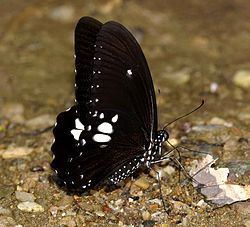Higher classification Papilio | Family Papilionidae Scientific name Papilio castor Rank Species | |
 | ||
Similar Butterfly, Swallowtail butterfly, Papilio, Papilio nephelus, Papilio alcmenor | ||
Papilio castor, the common raven, is a species of swallowtail butterfly found in South Asia.
Contents
Description
Male has the upper wings black, more or less irrorated (sprinkled) with yellowish-brown scales that form on the forewing somewhat indistinct longitudinal cell-lines and internervular streaks. The hindwing has an upper discal cream-coloured patch composed of an oval spot in interspace 4, a more elongate mark broadened outwardly in interspace 5, a similar elongate mark in interspace 6, and a much smaller broadly oval spot above it in 7; these markings not coalescent but distinctly divided by the black veins. Cilia on the forewings and hindwings are black alternated with white.
Underside of the male is duller, and more opaque than on the upperside; the brownish-black apical area of forewing and base of hindwing thinly sprinkled with yellowish-brown scales. The underside of the forewings has a small white spot on middle discocellular and a subterminal and terminal row of small white specks that do not extend to the costa. Hindwing markings are similar to those on the upperside but smaller, more widely divided one from the other by the veins which are edged with black; a subterminal more or less well-defined series of small white lunules and a terminal series of white specks. Antenna, head, thorax and abdomen black; on the underside of the body a spot behind the eyes and white spots and specks on the thorax and abdomen.
The female has the upperside a duller more opaque black than in the male but more densely irrorated with yellowish or reddish-brown scales. The forewing markings are as in the male, with in addition postdiscal and terminal series of small white spots that generally do not extend to the costal margin. The hindwing has a discal series of diffuse broad whitish streaks in the interspaces that extend into the apex of the cell, followed by a complete transverve curved subterminal series of white lunules; the ground colour beyond each lunule devoid of the irroration of yellowish-brown scales; this gives the appearance of a row of terminal black spots impressed on the wing. Cilia black alternated with white. Underside similar, the white markings larger and more prominent. Forewing: diffuse whitish streaks in interspaces la, 1 and 2, and the subterminal and terminal series of white spots complete. Hindwing with diffuse whitish streaks that extend up to the base of the wing. Antennae black; head, thorax and abdomen dull brown spotted with white.
Race mehala, Grose-Smith
The male has the upperside velvety dark brown; there is a minute white spot on the middle discocellular and a series of terminal white specks in each interspace. The hindwing has a discal series of seven elongate, more or less inwardly conical, outwardly emarginate cream-coloured spots, followed by a subterminal series of lunular small white spots. Cilia black, alternated with white in the interspaces. Underside brownish-black, markings similar. Forewing with the terminal series of white specks elongated inwards. Hindwing: the markings somewhat larger. Antenna, head, thorax and abdomen brownish black; head, thorax and abdomen speckled with white.
The female is similar to the male, but on the upperside, it has a subterminal series of white spots on the forewing, sometimes with the anterior ones enlarged, sometimes with the series incomplete. Hindwing is as in the male.
Distribution
Northeast India and into Myanmar, Bangladesh and Southeast Asia.
Systematics
Papilio castor is the nominate member of the castor species group. The clade members are:
